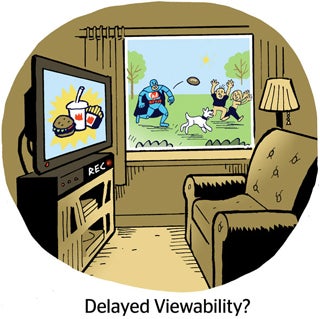 The viewability standard may be better served by saying what it isn’t, rather than what it is.
The viewability standard may be better served by saying what it isn’t, rather than what it is.
“Viewability does not guarantee that an ad will be looked at, or that an ad will be appealing, or have an impact or generate awareness or change brand perception,” said Sherrill Mane, SVP of research, analytics and measurement at the IAB. “Viewability has nothing to do with how well an ad works.”
What it is, Mane said, is the opportunity to be seen, “and the opportunity to be seen can’t tell you if an ad worked or not.”
That’s what sits at the heart of the fundamental misunderstanding that’s been brewing in the industry since March 2014, when the Media Rating Council (MRC) issued its viewable impression guidelines for display – 50% of pixels in view for a minimum of one second – and lifted its advisory against buying and selling display ads based on viewability metrics. The ability to trade on video viewability – 50% of pixels for a minimum two continuous seconds – followed a few months later.
The word “minimum” is key, said Duke Fanelli, EVP and CMO at the Association of National Advertisers, which, although it represents a membership of large brands, has stood firm in its support of the MRC.
“People misunderstand what the minimum means,” Fanelli said. “People say things like, ‘You can’t see the creative in one second with only 50% of the pixels showing!’ – but the standard has nothing to do with creative. It’s literally just the opportunity to see, and that’s what we keep trying to stress. The intent was to create a baseline where people could start from.”
In other words, if particular agencies, publishers or brands want to hash out their own deals above the standard, they’re more than welcome to.
“People can and should engage in whatever they want above that baseline,” Fanelli said.
But that hasn’t sat well with several large publishers, agencies and brands, among them Mindshare/GroupM, Condé Nast, American Express and Unilever. In November, Unilever and GroupM contended that ads should be 100% in-view before they’re counted as viewable. The duo backpedaled a bit in April, noting that they don’t consider native ads to be part of the 100% in-view rallying cry.
“I think about it like this: The Environmental Protection Agency issues fuel ratings for cars, but that doesn’t prohibit Consumer Reports from doing their own or going against that score,” said Scott Cunningham, SVP of ad ops and tech at the IAB and general manager of the IAB Tech Lab. “The MRC is the EPA in that case. They issue the standard, and they set it based on the agreement of several bodies. But that doesn’t always take into account all of the methodologies from different vendors.”
Clarity On Disparity
And that’s a big issue sitting on the MRC’s plate right now – discrepancy reconciliation.
“The biggest challenge still rests around what’s creating the discrepancy between buyers and sellers in terms of the different measurement technologies and approaches, and how those are being accredited,” said David Hahn, SVP of product management at fraud and viewability vendor Integral Ad Science, which has MRC accreditation for its display and video viewability services.
It’s causing friction between publishers, advertisers and their agencies.
“Why is the data different between different vendors? That’s a fair criticism and a definite challenge,” Hahn said. “It takes a lot of work to resolve for the different technologies. Whether the onus is on the MRC or the individual buyer to have an understanding of the different technologies – I’m not sure what the right answer is.”
George Ivie, CEO of the MRC, acknowledges that this is a legitimate and ongoing pain point for buyers and sellers alike.
“If you tag an ad campaign for the measurement of viewability and you choose more than one viewability vendor to do it, some of the numbers you get from each are going to differ one from the other,” Ivie said.
The MRC has issued a series of what it calls “reconciliation guidelines” to bring the difference in viewable impression counts between vendors into better alignment, including tips around how to handle nonrendered served ads, out-of-focus conditions – browsers will often render images without full crispness and clarity until they move into the viewable window – and straight-up human error.
“Some of the guidelines are really granular, dance-on-the-head-of-a-pin things, but they’re increasing the consistency we’re seeing in measurement between vendors,” Ivie said. “What started off as a difference as high as 30% is now more under control.”
 The truth is that there are actually only a couple of ways to measure viewability, but every vendor executes them slightly differently, Ivie said. That’s where the discrepancies creep in.
The truth is that there are actually only a couple of ways to measure viewability, but every vendor executes them slightly differently, Ivie said. That’s where the discrepancies creep in.
“By our estimate, there are more than 50 vendors out there measuring viewability, and we’ve accredited around 15 of them,” Ivie said. “But if you’re a marketer or an agency or a website, you can be approached by any one of these organizations and they’ll talk about how unique they are. But there are only two ways to measure viewability.”
One method, called geometric triangulation, uses known points on a web page to determine in milliseconds whether an ad has moved into the viewable space of a browser. The second method, dubbed browser optimization, involves tracking signals being sent by the browser, like the frame refresh rate. For example, to save bandwidth, browsers will often render images as blurry until they enter the viewable space. When an ad enters the viewable space, the frame refresh rate increases, and the ad renders clearly, thereby signaling that the ad is viewable.
The majority of vendors will use one or both of these methods as part of their not-so-secret sauce.
A Peek Inside The MRC
Because of the terms under which the MRC was founded in the 1960s (it was started by the US government as a self-regulating not-for-profit industry body in reaction to the quiz show ratings scandal in the late 1950s), it’s the council’s job to evaluate any vendor that approaches it.
“We were formed to legitimize measurement services, and if a company comes to us and wants to be accredited, we have to audit them,” Ivie said. “We have to give them the opportunity to be legitimized.”
That leads to a situation in which the MRC is obliged to audit and potentially accredit vendors before a standard has been set. At that point, the accreditation process – a fairly detailed ordeal – involves answering the fundamental question: Does this vendor’s technology actually do what it claims?
“But all of those vendors we audit before the standard is issued know that when the standard is final, they have to adopt it or they lose their accreditation,” Ivie said.
Considering that the MRC is a team of just six full-time staff, the council acts more as an oversight body, contracting work out to audit firms with large 50+ person tech teams, like PricewaterhouseCoopers, Ernst & Young and Deloitte.
“It’s a challenge to keep up with the technology, yes, but the real challenge comes in keeping our standards up to date,” Ivie said. “The moment we issue a set of standards, the clock starts to tick. The display impression standard is only a year old, and in the time since we wrote it, some browsers have introduced page visibility APIs, and Flash introduced a tool that can tell you whether an ad is becoming viewable or not. We now have to go back and look at the standard to decide whether to change it according to what’s evolving in the tech environment.”
The 100% Debate
At this point in the game, the IAB’s Mane called the viewability debate more of an “N and N” situation – nuance and negotiation.
“It’s much more about negotiation around measurement right now than it is about people who just don’t know or don’t understand,” Mane said. “There are many nuances around measurement that still need to be worked out, but there does seem to be an understanding coalescing around the idea that not every ad will be 100% viewable all the time. For a while that was not understood, but it’s starting to be understood now.”
When the IAB issued a report in December stating that 100% viewability for campaigns isn’t yet possible – it stated that 70% is a more realistic number in the short-term – the 4As (American Association of Advertising Agencies) sent a letter to its members stating that until 100% viewability is a reality. “Clients should be expected to pay only for the portion of the campaign that was measurable and viewable,” it read.
And that’s still where the 4As – and the ANA for that matter – stand today.
“Our position is that our members only want to pay for viewable impressions,” said Bill Tucker, EVP of the 4As media practice. “That does not mean we think 100% viewability can be achieved at this time – it cannot. But we need to continue to work to deliver as close as we can to 100% viewability when driving campaigns, so we can build business for our clients. That’s our focus right now.”
Ivie and the MRC agree – to a point. A single ad can be 100% viewable, but it’s not technologically feasible to apply that same percentage to overall campaigns, he said.
“If an ad has no opportunity to be seen, it shouldn’t be counted and, accordingly, it shouldn’t be monetized. Viewability is a binary function – either you meet the criteria or not,” Ivie said. “A marketer can say that they only want to pay for ads that are viewable, but they shouldn’t expect that their ad campaign is going to be 100% viewable. What they could do is cherry-pick out impressions that are 100% viewable and just pay for those, and have their sell-side partners sell more impressions until they get to the goal.”
It’s a situation that will lead, at least in the near term, to inventory scarcity and higher prices.
“When people say they only want to pay for 100% viewable impressions, I don’t think they fully understand just yet how much available inventory is shrinking because of that decision, and it’s significant,” Ivie said.
















